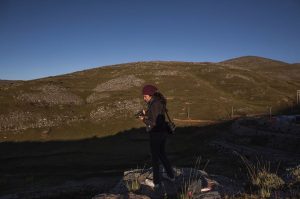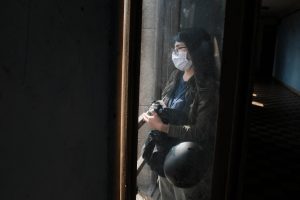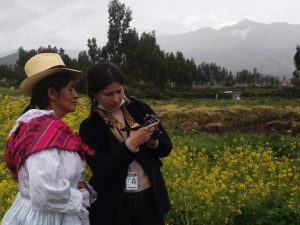Half a century has passed since women entered the photojournalism world in Peru. They have overcome challenges, documented crises and social change, gained space and labor rights. Shoulder to shoulder, she has fought for each photo alongside men.
However, globally, just 15 percent of photojournalists were women, according to a 2015 study by the Reuters Institute and World Press Photo. Of those surveyed, 72 percent of women news photographers said they were self-employed.
A 2020 survey of 105 women photographers in Peru found that photography was the main source of income for just 48 percent. The biggest challenge for a majority of respondents (61 percent) was more work opportunities for women photographers, according to the survey from Reveal: Collective of Women Photographers in Peru.
The COVID-19 pandemic in the Andean country, which according to the Financial Times has recorded the highest excess deaths per million inhabitants in the world, has meant that young independent women photojournalists have witnessed drastic changes to the labor arena. In addition, because they are women, their work is affected by practices that can make their work precarious. Likewise, young photojournalists have been creating collective spaces with the impulse and motivation in these times of change to generate new narratives and platforms.
Three freelance women journalists talked to LatAm Journalism Review (LJR) about this new working environment and the changes it brings.

Photojournalist Leslie Moreno said: "Traveling implies investing in your safety equipment, to prevent spread of the pandemic" (Courtesy)
“We independent women photojournalists have been reflecting on the dynamics of working in these times of pandemic and the changes that are taking place and that we are experiencing today,” photojournalist Leslie Moreno told LJR. “We do not have insurance or benefits. Traveling implies investing in your safety equipment, to prevent spread of the pandemic that is happening in the country, if, for example, you go to Loreto, a jungle area near the border with Brazil, there is no hospital with an ICU bed, oxygen, nothing.”
“What is happening is that the coverage of information on the scene of events is carried out above all by those who take the images, the women photojournalists, us,” she added. “The writers report from their offices or homes, they are not the ones who go out to cover the information, we are reporting alone: we cover by bringing data, we carry out interviews and collect testimonies from the place, we contribute by producing information.”
Moreno, a journalism graduate with a Master's degree in visual anthropology from the Catholic University who is interested in working on issues of conservation, human rights and Indigenous peoples, has had to postpone projects due to the difficulty of accessing vulnerable populations in Lima or in regional areas, a prospect that has become normal for the majority of freelancers.
Angela Ponce, a photojournalist who has worked for various newspapers in her country for four years, has a similar opinion about these changes in coverage that women photojournalists have often been doing alone: "this practice was already being done before the pandemic, it has become customary for the writers to send you their questions via WhatsApp, you record them, the writer follows the news or coverage on television, and they are provided with phone numbers so that they can communicate with sources or interviewees. The male or female photojournalist takes photos, videos, journalistic information, the writing is done from home especially or from the office, we are all young people on average,” the photojournalist told LJR.
However, part of this new normal meant accelerated learning and the need to intervene in the processes themselves, something that has been a challenge for women independent professionals.
French-Peruvian photographer Florence Goupil said that as a child, she imagined covering the war stories she read by Arturo Perez Reverte, and that she began her graphic reports photographing Shipibo-Conibo communities in the Peruvian Amazon. She told LJR that this whole process has become more of a challenge.
“Now, as professionalization progresses, you handle more of the processes of your work, editing, narrative, retouching. The choice if you want to work in black and white is indistinct in these times, there is no standard,” she said. “The development of a narrative makes you known for a particular way of communicating certain issues, for example, from my work with the Shipibo-Conibo community, other media have asked me to include nature, plants, the environment in my reporting. I believe that everyone must have a personal process of finding the formats that they want to work with, that can change, in my case, I am very traditional, I work with photos and audio, what is oral.”
Challenges to being a woman photojournalist pre- and mid-pandemic
Working in print media, especially national and traditional outlets, has made women photojournalists see how their presence in the graphic areas of traditional print media has decreased in Peru.
Moreno told how sharing commissions with women photojournalists in the media a few years ago, she received advice not to dedicate herself to photojournalism, that it was better to be a journalist. She already saw the decrease in female photojournalists in the traditional print media, which led her to consider that perhaps her thing was to contribute as an independent photojournalist in topics or stories that are narrated from the experience of women.
At the start of the pandemic, Moreno had an unfinished project. They were portraits of young people from various places on the outskirts of Lima whose mothers were seeking cannabis treatment for their ailments or illnesses. The photojournalist took a challenge to continue with the project from a distance; the mothers themselves would take pictures with her instructions. It was possible in just one case. She then resumed the project and took the photos herself. In order to continue communicating with images using a gender perspective, she said photojournalists must consider different ways and strategies that perhaps others are already using.
The three photojournalists coincided in pointing out that in their country, the trend in traditional print media, when it is necessary to reduce personnel, is not only to reduce the presence of women. The coverage topics for the few that remain in the newsrooms are less important than what is covered by male colleagues, they said.
This vision is contrary to what the women photojournalists find as total openness on the part of the foreign press and news agencies.
Angela Ponce said it was such that in the four years that she worked for media in her country, on very few occasions she found female photojournalists working for national media outlets.
“In a media outlet where I worked, once they had to get me accreditation to cover soccer. My editor suggested they accredit me, but they said no, someone of weight should go. Then a man was accredited. For me, it was normalized that as a woman, I already knew what commissions they were not going to give me,” she said. “Somehow, I got tired of thinking about the opening of the traditional media, when in the marches at the end of last year, they did not give me those commissions because I was a woman, while in foreign media they told me if I wanted to cover. They and the news agencies from abroad have the practice of giving importance to the gaze of a photojournalist woman, they have a greater openness.”
And, it is not only about the greater openness, but also about the improvements and the working circumstances foreign media also give to their collaborators, they said.
Ponce, at the beginning of the pandemic, did not have many assignments. However, the demand has recently grown and the working conditions and income have also improved; some of the news agencies provide a risk bonus in addition to the rate for daily work. She has had months in which he has had few assignments, and others, like these last three months, that are equivalent to an annual income.

Fotoperiodista Angela Ponce: "For now, working alone, as an advantage, allows me to decide freely." (Courtesy)
“I am single, but if I had a family burden, or I had to pay insurance for my photographic equipment, or I became ill, or my photographic equipment was at risk, the investment would be much higher,” she said. “For now, I have had to move to live alone so as not to put my parents at risk, not everything is profit, I have to maintain protocols, tests. I imagine of course, as a female photojournalist, if I had a family, I would have to prioritize the risk for my loved ones, children, family. For now, working alone, as an advantage, allows me to decide freely.”
Florence Goupil also highlighted not only the openness to the woman’s view by foreign media with whom she collaborates, but also the mutual need for this gaze to be present in reports specifically on gender issues.
“Recently, I had to photograph women sterilized during the Fujimori government in Cusco, for Le Monde, a media outlet that recognizes there is a feminine gaze. We had to be women who took photos and wrote text,” Goupil told LJR. “This process [of acceptance] here in Peru is very slow, and if added to this is the fact that access to education for women who are in the regions and want to be journalists, the spaces of education and related costs are high, it’s not possible for women from the interior to access it. An outlook is also presented where the outside media are more open to asking photojournalists to do their coverage in their own regions, it no longer happens that it is the same person that has to come from outside to take the photo.”
This new generation of independent photojournalists has the challenge of envisioning a future that, despite everything, allows them to see that they can dedicate themselves to photojournalism. Goupil commented that she does not know many women photojournalists of her generation who are mothers, a panorama that she does see in other countries with greater openness. She said that a colleague in Chile has been able to work with her 2-year-old son and the media outlet has understood it.
According to that 2020 survey from the Collective of Women Photographers in Peru, just 15 percent of women photographers said they were mothers.
Collectives, platforms, social networks, calls and financing: The quest to live on passion
It has become a sign of these times for the use of digital media and platforms to generate income to spread images and projects that are finding shape as collectives of women photojournalists around the world are articulating, communicating, and also supporting one another professionally and emotionally. Being a young woman photographer often means fewer initial opportunities, Goupil observed.
“This generation has few references, having to go out in search of a work space, the parents of young people who want to forge themselves in photojournalism still have stigmas: they will not give resources to their daughters, they think that it is a very insecure medium, it is better that a man accompany them to their work,” she said. “We still experience difficulties such as workplace harassment, difficulty talking about it and seeking the right thing when it is also about a person in a higher rank than you, you think, ‘who is going to believe you?’ For this reason, the need to have spaces for dialogue such as the collectives, where we also talk about this type of problem among ourselves, with a future perspective of offering workshops.”

Photojournalist Florence Goupil works in Ancahuasi. (Courtesy)
Today, Instagram is the ideal meeting place for these women who enter the profession. They can share common interests. There, they disseminate their work, generate more empathy and contribute to the content of one another’s projects, facilitate dissemination and promote new narratives. Synergy contributes to the best presentation of their proposals, an enriching experience for them. For Moreno, these meeting platforms are very relevant for women photojournalists. It’s where a woman better understands another woman in her circumstances and the situations that she is experiencing.
This social network has also been rewarding photojournalists with better job prospects, as in the case of Ponce, who validates the use of Instagram more as a space for self-promotion.
“It works like a portfolio, they visit it more than your own website. I do not post personal topics, it is a professional approach,” she said. “The more you publish what you do, the more opportunities you have to be called. It is also important to highlight when you are traveling, where you are, so they can tell you to make a record in that place. I have stopped using Facebook.”
The use of Instagram as a portfolio is also highlighted by Goupil, who considers that most media editors see it that way. It is important to produce good texts, to work on captions in the platform, to be well-detailed about the facts, to write them in English, Spanish. But, regardless of how they develop the posts, not forgetting the objective, the motivation, the personal, human language, how they are represented and told. That’s the priority.
One aspect that should be highlighted within the organization and idea of joint work between photojournalists is the growth of photography collectives in Peru, such as @Revelarse, or in Latin America, including @RudaColectiva. Goupil and Ponce are part of the Revelarse team.
For photojournalists, the collectives are an outbreak or a response to the growing need to make their situation more visible and have more job opportunities. Young people who are mothers and cannot find work because they do not have a place or person with whom to leave their children, or because they live in regions far from the capital, they are not known, and they have to dedicate themselves to taking other types of photography. They have in these collectives the space to make their narrative visible or find job opportunities and grow alongside other colleagues, sharing their experiences.
For Ponce, the collectives are a means of constant renewal and search for opportunities that are presented in the virtual environment, ideal for accessing, for example, a portfolio review.
In still uncertain times and of much change and flow of images and information, independent photojournalists coincide in pointing out the urgency of looking for sources of financing. They make constant searches on the pages that post calls for photography projects and send their applications.
"They are on social networks, you can access to see them, the problem is the language, most in English, perhaps that is why very few apply, or understanding how you apply or present the topic you want to develop can be tiring," Ponce said.
Photojournalism has the task of making visible the harsh reality in this context of a pandemic that has already led to more than 3 million deaths. Female photojournalists are having the dual mission of showing harsh images and humanity in the midst of this juncture. The need to create groups of exchange, dialogue and mutual support is strengthening the collaborative work of women photojournalists in Peru, as was also revealed at the event “Women journalists facing the pandemic,” from the National Association of Journalists (ANP). May the strength be not forgetting why we are taking these photos, what we tell and represent, our responsibility, Goupil said.